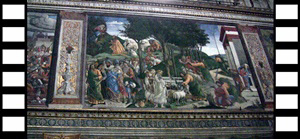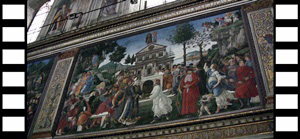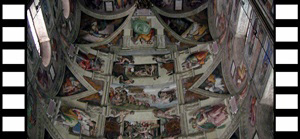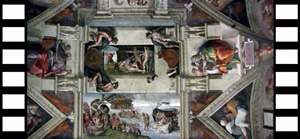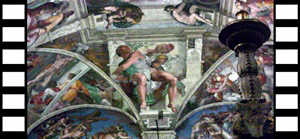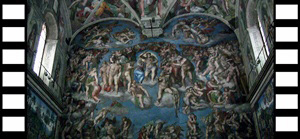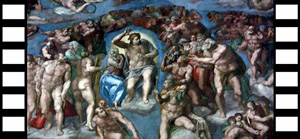The Sistine Chapel
The Sistine Chapel is part of the Vatican Museums and is a reconstruction of an earlier chapel
that existed on the same spot, called the Capella Maggiore. The demolition and rebuilding
of the chapel took place between 1473 and 1481 under Pope Sixtus IV, from whom the name of the
new chapel was derived. The chapel was built to the same dimensions as the Temple of Solomon,
according to the Old Testament (134 feet x 34 feet). At the time of its building, the Pope asked
the leading frescoists of the time to contribute works to two themed series of frescoes along the
walls. The series would depict scenes from the life of Moses and from the life of Christ. Among
the artists were Botticelli, Ghirlandaio and Perugino. The ceiling was painted bright blue, with
a pattern of gold stars. The new chapel was consecrated in 1483. Most of the frescoes remain,
though the ceiling has changed.

South Wall Frescoes - Stories of Moses

Events in the Life of Moses, Sandro Botticelli (1481-82)

Passage of the Red Sea, Biagio d'Antonio (1481-82)

Punishment of Korah, Dathan and Abiram, Botticelli (1481-82)

Legacy and Death of Moses, Luca Signorelli (1482)

Chapel Pulpit

North Wall Frescoes - Stories of Christ

The Baptism of Christ, Pietro Perugino (ca. 1482)

The Temptations of Christ, Botticelli (1480-82)

Calling of the First Apostles, Domenico Ghirlandaio (1481-82)

The Handing Over of the Keys, Perugino (1481-82)

The Last Supper, Cosimo Rosselli (1481-82)
In 1503, Giuliano della Rovere was selected to be the new Pope, and chose to go by the name
Julius II. Julius was energetic and determined to shake things up. Among the projects he
commissioned were the Raphael Rooms (see previous page) and a complete rebuilding of St.
Peter's Basilica (more on this later). In 1505 he commissioned a young but already accomplished
Florentine artist named Michelangelo Buonarroti to design and build a grandiose tomb for him, to
be installed eventually in the new Basilica. Michelangelo was already famous for having
sculpted a Pieta (1498-99) for a French Cardinal and the incomparable statue of
David (1501-04) for the city of Florence. Unfortunately he never got too far on the
tomb, as the Pope and others kept pulling him off the project to do other things. Only one of
the many planned sculptures for the tomb was ever completed, a statue of Moses. This statue,
and Julius' scaled-down tomb are now in the San Pietro in Vincoli Church in Rome. Some
of the unfinished sculptures can be found near the David statue in Florence (see
the Galleria dell'Accademia page),
where they have been called "slaves", as they seem to be struggling to emerge from the stone.
The first client to pull Michelangelo off the Julius II tomb project was Julius II. He'd
decided that the ceiling of the Sistine Chapel should be repainted with depictions of the
twelve Apostles, and Raphael and Donato Bramante (the first architect of the new Basilica)
highly recommended Michelangelo for the job. Michelangelo was puzzled by this recommendation,
as his experience with the difficult medium of fresco was limited to a small amount of work
during his apprenticeship under Domenico Ghirlandaio back in Florence, and he considered
himself to be pretty much exclusively a sculptor. He eventually decided Raphael and Bramante
were trying to set him up for failure, and he tried his hardest to get out of this new
commission, even fleeing back to Florence at one point. But Julius was nothing if not a
determined Pope, and Michelangelo eventually had to give in, though he managed to get
permission to paint biblical scenes of his own choosing, rather than the twelve Apostles. He
ended up choosing nine scenes from the Book of Genesis as the principal subjects.

Pope Julius II, Raphael (1511)
Frescoing as done by Michelangelo and others was essentially painting on wet plaster – conceptually
simple enough, but complicated in execution. First, the artist needed to plan out what to
paint. This was normally done by making large drawings on paper, called cartoons. Next,
plaster had to be properly mixed and applied to the wall or ceiling, difficult to do properly
and unpleasant because of the corrosiveness of the quicklime used in the plaster, which ate away
at brushes, clothing and skin. The outlines of the subject matter then had to be transferred
from a cartoon to the plaster, often done by poking pinholes in the cartoon, holding it up to the
plaster and blowing powdered charcoal through the holes. Finally, the artist had to paint like
crazy before the plaster dried, so the paint would become "part of" the plaster. For this reason,
only small patches of plaster were applied for a given day. Michelangelo had assistants who
performed some of the manual labor and did some incidental painting, but even so, the whole
process was horribly tedious.
Michelangelo started out tentatively with a scene of Noah's Ark and the flood, but his
compositional and technical skills increased rapidly, leading him early on to dispense with
cartoons entirely, just painting directly on the plaster. Despite depictions to the contrary,
he painted in a standing position, using hanging scaffolding of his own invention. Between 1508
and 1512 he executed 5,000 square feet of fresco, covering the ceiling and upper walls with
painted plaster. When the ceiling was unveiled, it was quite the sensation, and it heavily
influenced many artists immediately and for the centuries to come. Here are the Genesis scenes:

The Ceiling (inverted)

The Ceiling

God Divides Light from Darkness

God Creates the Sun and Planets

God Divides the Water from the Earth

God Creates Adam

God Creates Eve

Temptation and Expulsion from Eden

Noah and Family Make a Sacrifice

The Great Flood
Noah Drunk and Disgraced

Connie Looks at the Ceiling

Closeups of Ceiling Panels
You may have noticed a lot going on besides just the Genesis scenes. There are also scenes
in the corners related to the salvation of Israel, assorted prophets and sibyls, scenes
from the lives of the ancestors of Jesus, and a bunch of naked guys called ignudi.
The Prophet Zachariah

David Slays Goliath

Eritrean Sibyl and Family Picture

The Prophet Ezekiel

Persian Sibyl and Family Picture

The Prophet Jeremiah

Haman is Denounced and Slain

Jonah

Moses Raises Up the Bronze Serpent

Libyan Sibyl and Family Picture

Daniel

Family Picture and Cumean Sibyl

Isaiah and Delphic Sibyl with Family Picture

Delphic Sibyl

Delphic Sibyl, Zachariah and Judith Slays Holofernes
In 1537, Michelangelo was summoned back to the Sistine Chapel by Pope Clement VII, who asked
him to paint a fresco on the Sistine Chapel's altar wall depicting The Last Judgment.
Michelangelo was more agreeable this time, and the new fresco ended up also taking four years.
It illustrates the second coming of a clean-shaven Christ and the Apocalypse, with souls
being either elevated to Heaven or condemned to Hell. During the painting, the Pope's Master
of Ceremonies, Biagio da Cesena, complained about all the nudity. Michelangelo accordingly
worked Cesena into the fresco as the Judge of the Underworld and gave him donkey's ears. 24
years later, another artist was assigned the job of covering up all the genitalia, to the
derision of the other artists of the time and since. In 1993, the fresco was restored, and
in the process, some of the nakedness (including Cesena's, whose genitals are being bitten by
a snake) was returned to its original glory.

Ceiling, Altar Wall and Screen

The Last Judgment

The Last Judgment, center

The Last Judgment, left

The Last Judgment, Souls Being Saved

The Last Judgment, bottom center

The Last Judgment, right

The Last Judgment, Welcome to Hell
The Last Judgment, Details
The Sistine Chapel is used regularly for Papal ceremonies that don't require the cavernous
space of St. Peter's Basilica, and is used as the location where new Popes are elected by the
College of Cardinals when the need arises. It's probably the most crowded area in the Vatican
Museums. There are signs at the entrance to the Chapel that seem to indicate that photography
(or maybe just flash photography?) is against the rules, but whatever the rule is, it's
universally ignored (it's the Sistine Chapel, for goodness sake). There is an employee posted
in the Chapel to keep an eye on the tourists, but on our visit his main concern seemed to be
the noise level, as he kept shushing everyone over a PA system. He didn't seem to have a
problem with the picture-taking.
From the Sistine Chapel we followed the designated path to the Museum exit, back near the
entrance. From there we followed the boundary wall to our next Catholic attraction, St.
Peter's Square.


